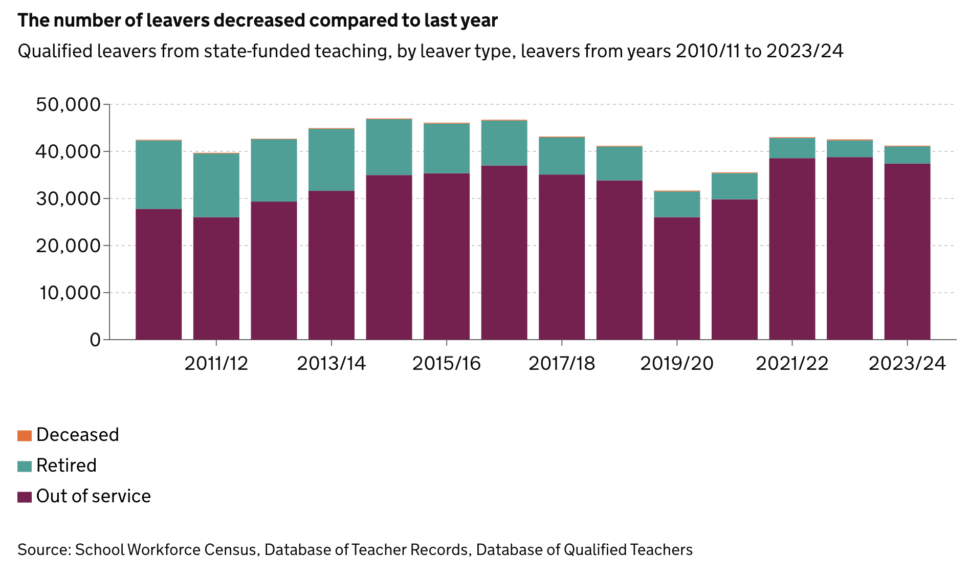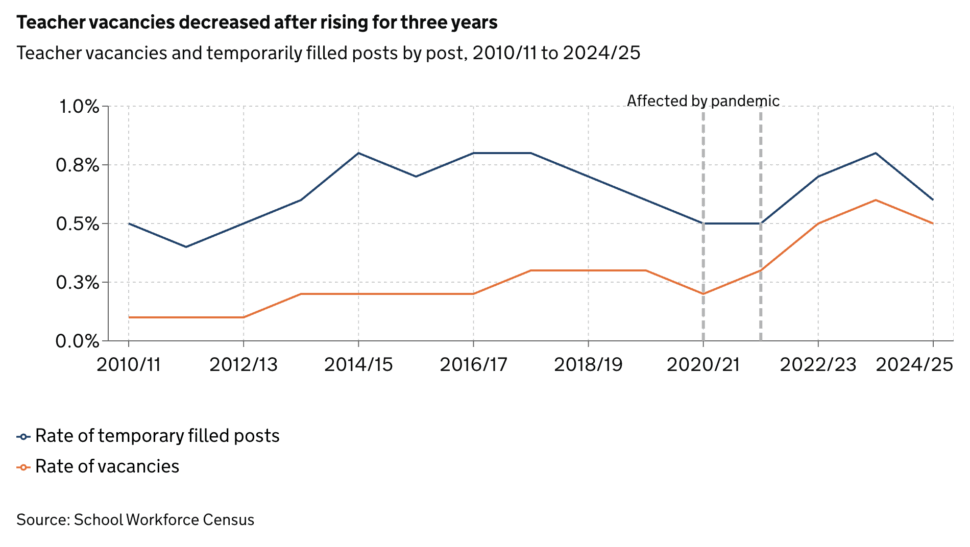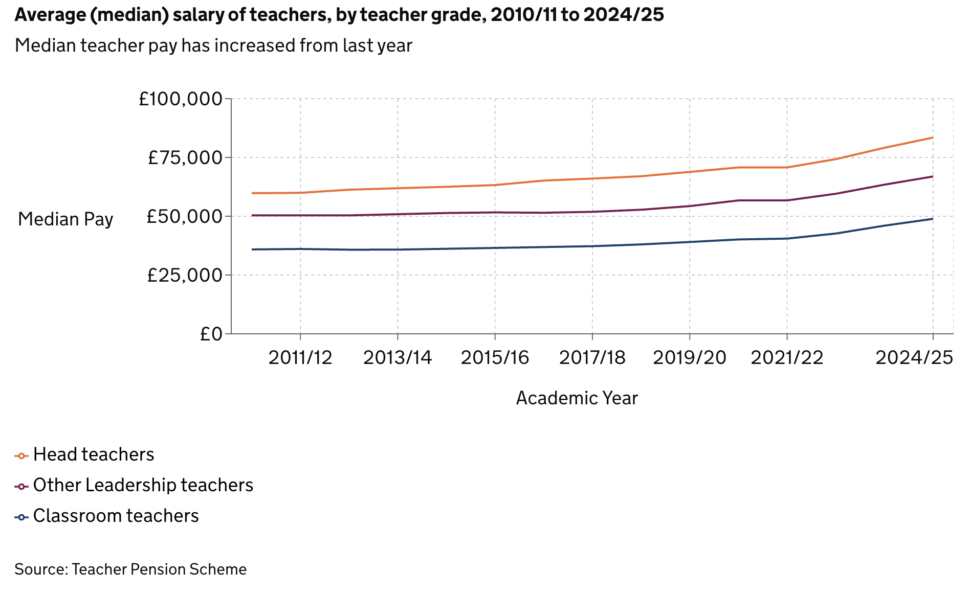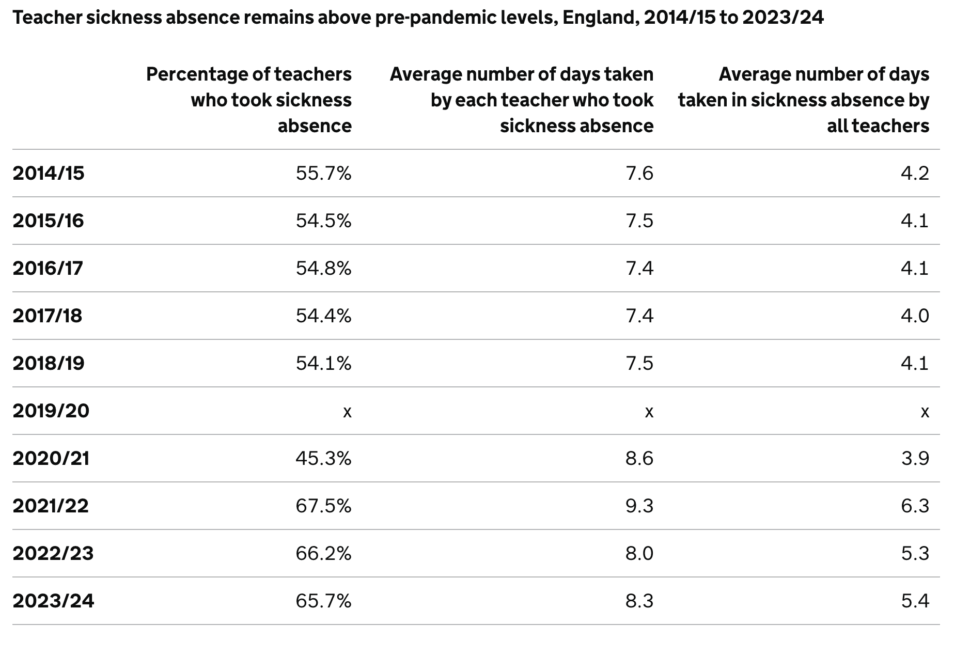The number of teachers in England’s schools has shrunk for the first time in years, as new data suggests recruitment and retention pressures may have eased slightly.
New workforce data for 2024, released this morning by the Department for Education, shows vacancies have fallen by over 20 per cent, with retention rates for new teachers also improving and more teachers returning to state schools.
Education secretary Bridget Phillipson said she’s delivering on her “pledge to recruit an additional 6,500 expert teachers, with more joining the profession in our secondary and special schools and over a thousand more people intending to train”.
However, experts have cautioned that “the effects of sustained under-recruitment and poor retention continue to be felt” across the sector.
Here’s what you need to know…
1. Teacher numbers shrink for first time in years
The number of full-time equivalent teachers reduced by 400 since last year to 468,300, the first fall since 2017-18.
But government said this “aligns with changes in the pupil population” as nursery and primary full-time teachers decreased by 2,900 (1.3 per cent), but secondary numbers rose by 1,400 (0.7 per cent).
This means there are now more teachers at secondary than primary for first time since 2013.
Meanwhile, the numbers working at special and PRU increased by 900 (3.2 per cent).
2. Fewest ever teachers join (but more returners)
The number of full-time teachers joining the sector stood at 41,700, down 1,400 since last year.
The figure is lower than any stage since figures were first recorded in 2011-12.

This includes new teachers (41 per cent), but also teachers joining the state sector and those returning.
But the rate of those returning to the profession is the highest since 2014-15.
In all, 17,274 returned to teaching, up from 16,985 in 2023-24. The figure has risen every year since 2021-22.
James Zuccollo, of the Education Policy Institute, said this suggests teaching jobs are “becoming more attractive”.
He thinks it “will be crucial for the government to understand what has led to these improvements and build on that success as they develop their teacher workforce strategy”.
3. Fewer teachers quitting, but numbers still high
About 41,200 full-time equivalent (FTE) teachers left their jobs in 2023-24. This is down on 42,600 in 2022-23 and the lowest since 2020.
Most of last year’s leavers (91 per cent) quit their roles for jobs outside the state sector.
Over 1,600 heads left for a job outside the state sector in 2023-24. In 2010-11, the figure stood at 438.

Zuccollo noted heads “are nearly four times more likely to quit their role for careers outside of state schools than they were in 2010”.
“The loss of experience in teaching and leadership is particularly concerning because of the effect it may have on the quality of teaching.”
EPI research shows “attainment remains lower, and the disadvantage gap wider, than before the pandemic so keeping experienced teachers in the profession is critical for the years ahead”.
4. Retention rates improve for new teachers
Retention rates for the two newest cohorts of teachers increased.

Just under 90 per cent of those who earned their stripes in 2023 were still teaching one year on – up by 0.7 percentage points and higher than any point over the last 15 years when records began.
Meanwhile, 80.5 per cent of teachers who qualified in 2022 are still in the profession, up on 79.2 per cent previously.
However retention rates fell for most other cohorts.
But Jack Worth, of the National Foundation of Educational Research, pointed to “steady improvements to the retention rate” as one of the indicators suggesting “some green shoots of progress towards addressing the chronic issues in teacher recruitment and retention”.
5. Part-time rise drives down teacher numbers
The DfE also noted that the numbers entering and leaving the sector are “not the only factors that impact FTE qualified teacher numbers” – changes to working patterns have also had an impact.
Latest figures for 2024-25 show 4.4 per cent of the workforce increased their working hours, while 6 per cent reduced their hours.
This “produced a net decrease equivalent to 2,530 FTE qualified teachers since last year”, according to the department.
The gap has also grown. In 2023-24, more teachers increased their hours (4.8 per cent), and fewer decreased their hours (5.7 per cent) compared to this year. This equated to a 2,050 FTE decrease in teachers.
6. Vacancies come down, but still above pre-pandemic rates
The number of unfilled teaching jobs reduced to 2,200, having more than doubled in the previous three years from 1,100 in 2020, to a peak of 2,800 in 2023-24.
Vacancy rates also decreased to 5 per 1,000 teachers, from 6 per 1,000 in 2023. But levels remain higher than pre-pandemic.

Worth warned “the effects of sustained under-recruitment and poor retention continue to be felt by schools”.
He said next week’s spending review “provides an ideal opportunity to show a long-term commitment to increasing the attractiveness of teaching and delivering the government’s commitment to recruiting 6,500 teachers”.
7. Support staff numbers at 10-year high
Support staff numbers have risen every year since 2019-20. They now stand at 517,500, the highest on record.
DfE said this is “mainly due to an increase of 5,900 teaching assistants”, from around 283,000 to almost 289,000.
Two-thirds (65 per cent) of TAs work in nursery and primary schools, with 17 per cent in special schools and pupil referral units.
8. Average teacher pay almost £50k
Median classroom teacher pay rose by 6.3 per cent to just under £49,000 in 2024-25.
Headteacher salaries increased 5.5 per cent to over £83,000.
Average teacher wages are highest in inner and outer London (£58,800 and £54,000) and lowest in the east of England and east Midlands (both £49,000).

DfE noted male and female “salaries are broadly similar in most cases”. The exceptions were for secondary classroom teachers (among whom men earn 2 per cent more) and secondary heads (males are 5 per cent better off).
9. Leadership gender gap narrows
Figures show women remain less likely to be in leadership roles than their male counterparts, but the difference has reduced over time.
The proportion of leadership positions held by women rose by one percentage point to 70 per cent this year. Since 2010-11, the level has risen by 4 percentage points.
Overall, 76 per cent of the teaching workforce is women.
10. Sickness falls after post-Covid surge
The proportion of teachers taking sick leave leapt from 45 per cent in 2020-21, to 68 per cent the following year.
But latest figures show the figure dropped slightly to just under 66 per cent in 2023-24.
Those who took time off work took 8.3 days of leave, down from a high of 9.3.







Your thoughts